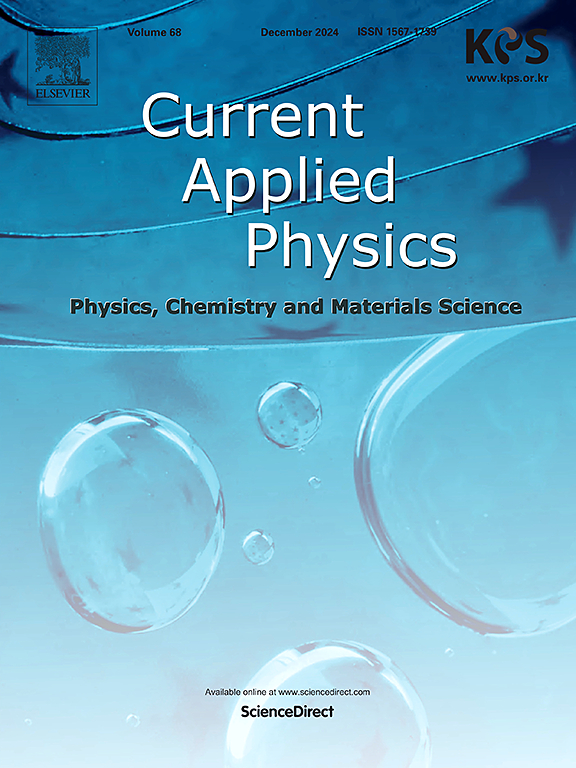Structural and optical properties of α aluminum oxide prepared by sol-gel method
IF 3.1
4区 物理与天体物理
Q3 MATERIALS SCIENCE, MULTIDISCIPLINARY
引用次数: 0
Abstract
Aluminum oxide (Al2O3) powders were prepared via sol-gel method. The samples underwent three-hours of calcination process between 1100 and 1200° C. An X-ray diffraction (XRD) was used to analyze structural properties, field emission scanning electron microscopy (FE-SEM) was employed to assess morphological characteristics, UV–visible (UV/vis) and Raman spectroscopies were used for determining the optical properties. According to the XRD data, the samples display α- Al2O3 type in the hexagonal structure. As the calcination temperature increases, the lattice parameters of both samples remain unchanged, recording values of a = 4.76 ± 0.10 Å and c = 12.98 ± 0.10 Å. The crystalline size increases from 35.0 ± 0.1 to 38.0 ± 0.1 nm as calcination temperature increases from 1100 to 1200 °C, respectively. At 1100 °C the sample shows the presence many pores mixed with needles-like structures; with a further increase in the calcination temperature to 1200 °C, the sample shows large and porous particles. There is no change in the energy gap with increasing calcination temperatures; their values of 3.8 and 4.5 eV are recorded. This could be due to the Al2O3 being stable at high calcination temperature. Raman spectra of both samples showed the active mode A1g located at 415 and 643 cm−1 and the other Raman active mode of Eg located at 376, 429, 575 and 749 cm−1, these results are close to Raman spectra for single crystalline α-Al2O3 but with slight differences in Raman peak positions which could be due to the disorder vibration of active phonon.
sanalysis are also discussed.

溶胶-凝胶法制备α氧化铝的结构和光学性质
采用溶胶-凝胶法制备了氧化铝粉体。样品在1100 ~ 1200℃之间煅烧3小时,采用x射线衍射(XRD)分析结构性质,采用场发射扫描电镜(FE-SEM)评价形貌特征,采用紫外可见光谱(UV/vis)和拉曼光谱测定光学性质。XRD分析表明,样品呈六边形α- Al2O3型。随着煅烧温度的升高,两种样品的晶格参数保持不变,记录值分别为a = 4.76±0.10 Å和c = 12.98±0.10 Å。煅烧温度从1100℃升高到1200℃,晶粒尺寸分别从35.0±0.1 nm增大到38.0±0.1 nm。在1100℃时,样品显示出许多针状结构的孔隙;当煅烧温度进一步提高到1200℃时,样品呈现出大而多孔的颗粒。随着煅烧温度的升高,能隙没有变化;记录其3.8和4.5 eV值。这可能是由于Al2O3在高煅烧温度下是稳定的。两种样品的拉曼光谱均显示,活性模式A1g位于415和643 cm−1,活性模式Eg位于376,429,575和749 cm−1,这些结果与单晶α-Al2O3的拉曼光谱接近,但拉曼峰位置略有不同,这可能是由于活性声子的无序振动造成的。并对分析进行了讨论。
本文章由计算机程序翻译,如有差异,请以英文原文为准。
求助全文
约1分钟内获得全文
求助全文
来源期刊

Current Applied Physics
物理-材料科学:综合
CiteScore
4.80
自引率
0.00%
发文量
213
审稿时长
33 days
期刊介绍:
Current Applied Physics (Curr. Appl. Phys.) is a monthly published international journal covering all the fields of applied science investigating the physics of the advanced materials for future applications.
Other areas covered: Experimental and theoretical aspects of advanced materials and devices dealing with synthesis or structural chemistry, physical and electronic properties, photonics, engineering applications, and uniquely pertinent measurement or analytical techniques.
Current Applied Physics, published since 2001, covers physics, chemistry and materials science, including bio-materials, with their engineering aspects. It is a truly interdisciplinary journal opening a forum for scientists of all related fields, a unique point of the journal discriminating it from other worldwide and/or Pacific Rim applied physics journals.
Regular research papers, letters and review articles with contents meeting the scope of the journal will be considered for publication after peer review.
The Journal is owned by the Korean Physical Society.
 求助内容:
求助内容: 应助结果提醒方式:
应助结果提醒方式:


